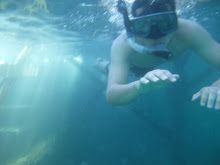ekranoplan or surface/screen plane is a ground effect vehicle
Ekranoplan or screen/surface vessel is a surface effect craft or wing in ground craft (WIG) developed by the Central Hydrofoil Design Bureau led by Alexeyev Rotislav and Alexander Lippisch in the Soviet Union.
The ekranoplan utilize high pressure air developed by the aerodynamic interaction between the craft wings and the earth surface thus the term wing in ground (WIG). Ekranoplan operates in an aircraft like manner but due to its reliance over surface effect to maintain level flight over the surface it could not fly like aircraft did. The International Maritime Organization considered ekranoplan as a type of watercraft since it operate above the water on certain height and does not operate or fly like an aircraft.
KM-1
Soviet Union is a major player in this technology and incorporate it for military purposes, hence the development of the Caspian Sea Monster by western observer as technology demonstrator.
KM-1 - the Caspian Sea monster
In 1966 the Central Hydrofoil Design Bureau under Rostislav Alekseev produced a gargantuan "ekranoplan" ("surface plane") combining the smooth hull form of a ship with stub wings, a large vertical fin and horizontal tail.
the large wing span and the 10 Kusnetsov engine provide lift and thrust for KM-1
The craft featured ten engines: eight mounted in two clusters of four directly behind the cockpit to provide augmented lift, and two on the vertical fin to provide cruise power. This vehicle could lift 540 tons and cruise at over 300 mph at an altitude of over 10 feet.
A-90 Orlyonok military high speed transport craft
A-90 ORLYONOK
Further developments of ground effect vehicle led to mass production version of ekranoplan for military purposes such as the A-90 Orlyonok and the MD-160 Lun of the Soviet Navy.
A-90 turning during flight - note the height between the craft and the surface is very low
The 58.1m length and 16.3m wide A-90 is crewed by six person and it is capable of carrying 150 troops and payload up to 28 000kg.2 Kusnetsov NK-8-4K turbojet engine and 1 Kusnetsov NK-12MK turboprop engine propelled this beast with cruising speed of 400km/h and operating range of 1500km, taking off with weight up to140 000kg.
coming out to sea
The A-90 were primarily used as high speed military transport vehicle and destined for Baltic and Black Sea fleet before funding were reduces and ceased by the Ministry of Defense thus reducing the number of ordered vehicle from 120 initially to fewer than 30 and finally with 5 units only.
A-90 in pair low-flight above Caspian Sea
In the end only three unit were comissioned and continue its service with the Soviet Navy before it was decomissioned in 1993.
MD-160 Lun class ekranoplan of the Soviet Navy with six SS-N-22 Sunburn anti ship missile launcher
MD-160 LUN
The Lun also faced the same fate with only one unit survive and completed by Central Hydrographic Design Bureau before projet funding ceased. It has 8 Kusnetsov NK-87 turbojet mounted at the forward located canard delivering 127.4Kn of thrust each propelling her to speed up to 550km/h and operating range of 1000km.
MD-160 Lun ekranoplan-note her 8 Kusnetsov NK-87 turbojet engine
Armed with six SS-N-22 Sunburn anti ship missile and a 23mm anti aircraft gun, the Lun were capable of surface to surface warfare though they were never deployed to fighting units.
search radar mounted on her aft wing to provide guidance for the missile and craft
The design provided an effective method of performing a premptive strike against an enemy fleet.But subsequently budget cutback and the collapse of Soviet Union saw the Lun project were discontinued.
Presently only civilian ekranoplan were built on a scale much smaller than their predecessor for the purpose of transport and recreational.
-come to sea and see for yourself-













No comments:
Post a Comment